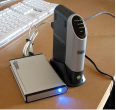 From time to time I get asked if it’s a good idea to use a low-cost NAS device (Network Attached Storage) as primary disk storage. In most cases, I say NO. Let me explain.
From time to time I get asked if it’s a good idea to use a low-cost NAS device (Network Attached Storage) as primary disk storage. In most cases, I say NO. Let me explain.
In an office environment, PC users frequently need to setup public folders so that information can be easily shared between workgroup members. One common approach is to install a dedicated Microsoft Windows server.
However, even an entry level Windows server will cost over $1,000 to purchase and probably an equal amount (or more) to configure. Ongoing management costs could also be substantial — making the Windows server a “budget-buster” for some small workgroups.
With a dedicated Windows server ruled out, one member of the team usually steps up and suggests the group consider an inexpensive NAS device. The logic is that by connecting a NAS device to the local network, end users can create a “mapping” from their local PC to a shared storage area on the NAS.
NAS devices can be extremely easy to deploy, are often managed via a web browser, and offer lots of hard disk storage for very little money. So, on the surface, a low-cost NAS device with a large storage capacity seems to be an ideal workgroup solution.
But, before you go out and buy a low-cost NAS device, let’s take a look at some of the negatives of this approach:
1. It’s “low-cost” for a reason – Low-cost NAS devices are often made with the absolute lowest quality parts. Customer support is frequently non-existent (swap out service only). Judging from my personal experience, many of these boxes fail in less than a year – and some within days of being deployed.
2. Performance can be slow – Random access performance of many NAS devices could be just 10% of what you would see compared to your own computer’s internal disk. Yes, NAS will attach to your 100 Mbps LAN, but the transfer rate is likely to be much slower.
3. Disk failure means data loss – If the disk inside of a NAS device fails, your shared workgroup folders are gone. Are you willing to put your team’s most important information on the lowest cost — and least reliable — form of storage?
4. Incompatible with live databases – Microsoft SQL Server databases are commonly used by Windows application software. You can’t use your NAS device (mapped drive) to host an SQL database. Might your applications require SQL? (now or in the near future.)
5. File create/modified times out-of-sync – The internal clock used in many low-cost NAS devices often fails to keep accurate time. This means that file timestamps may not be correct. On client systems, I often see file creation dates of January 1, 1990 12:00 AM – indicating a malfunctioning internal clock on the NAS. Incorrect file timestamps could cause various file synchronization tools to badly fail…sometimes resulting in unexpected data loss.
6. Lack of incremental backup support – Many NAS devices do not support the Windows standard “archive flag” feature. The archive flag is set on a file when content changes occur and let’s a smart backup program know if an individual file backup is needed. Without archive flag support, time consuming full backups of the entire device are often required. Any file which is left open (in use) on the NAS device cannot be backed up at all (until it is closed.)
7. Can easily be stolen – Many NAS devices are light-weight and small enough to be slipped into a coat pocket. It’s just too easy for these devices to walk out the door…along with your valuable data.
8. Maximum file size of 4,000MB (4GB) – Some low-cost NAS devices support individual files upto 4GB in size. If a large file copy to your NAS device fails, you should immediately return the device to the store where you bought it. Many multimedia files, backup archives, email archives, etc. routinely exceed 4GB in size. This restriction is just unacceptable in the 21st century!
So given all these negatives, what I would suggest?
If you have less than 10 devices in your workgroup, you might choose to nominate a lightly-used workgroup PC as your shared storage device. It’s highly unlikely that the person using this PC will even realize its dual purpose.
First, put a UPS battery on the device ($50) so that it stays permanently powered. Next, allocate some internal disk storage to be used as your shared workgroup folders. Finally, setup file security to permit shared access.
Some call this solution a “poor man’s server” but remember, before Microsoft introduced their server operating system, peer-to-peer workgroup solutions were common. One added benefit of this approach is that a group printer can also be shared — providing a place for wireless devices (like iPads) to print.
If you’ve already purchased that low-cost NAS device, why not just use it for local backup…since you can never have too much backup!
